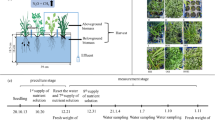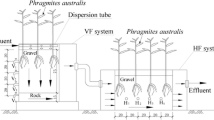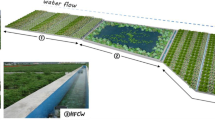Abstract
A hybrid pilot-scale constructed wetland (HSSF-FWS) with three horizontal flow components and a free water surface in series (HF-CW1 + HF-CW2 + HF-CW3 + FWS) was designed and investigated to evaluate seasonal wastewater treatment performance, the microbial diversity and community structure. The HF-CW1 component was planted with Scirpus holoschoenus and Cyperus papyrus; HF-CW2 was unplanted, whereas HF-CW3 was planted with Scirpus validus. In FWS, the wastewater was covered with Lemna minor and Daphnia magna. HSSF-FWS has a great potential to reduce chemical oxygen demand (COD), biochemical oxygen demand (BOD5), total suspended solids (TSS), fecal coliforms (FC) and fecal streptococci (FS), while the removal efficiencies of nitrate nitrogen (NO3−) and orthophosphorus (PO43−) were relatively low. The best removal efficiency was achieved in spring for COD and BOD5, in summer for TSS, in autumn for NO3− and in winter for PO43−, while no seasonal difference was found for the removal of FC and FS. The seasonal treatment performance is generally less influenced by the plant species than by the presence or absence of vegetation. HF-CW3 and FWS had different influences on treatment parameters; the FWS component improved the removal of TSS and PO43− during winter and the removal of COD and NO3− during spring season. Seasonal changes affect the microbial diversity and community structure throughout the hybrid constructed wetland and are enhanced by the presence of plants, with diversity changing with different plant species. Cluster analysis indicated that bacterial community structure from influent and FWS samples was closely related in autumn.






Similar content being viewed by others
References
Akpor OB, Muchie M (2011) Environmental and public health implications of wastewater quality. Afr J Biotechnol 10:2379–2387
American Public Health Association (APHA) (2005) Standard methods for the examination of water and wastewater, 21st edn. American Water Works Association, and Water Environment Federation (APHA, AWWA, WEF), Washington, DC
Baptista J, Donnelly T, Rayne D, Davenport R (2003) Microbial mechanisms of carbon removal in subsurface flow wetlands. Water Sci Technol 48(5):127–134
Bôto M, Almeida CMR, Mucha AP (2016) Potential of constructed wetlands for removal of antibiotics from saline aquaculture effluents. Water 8(10):465
Button M, Rodriguez M, Brisson J, Weber KP (2016) Use of two spatially separated plant species alters microbial community function in horizontal subsurface flow constructed wetlands. Ecol Eng 92:18–27
Caselles-Osorio A, Garcia J (2006) Performance of experimental horizontal subsurface flow constructed wetlands fed with dissolved or particulate organic matter. Water Res 40(19):3606–3611
Calheiros CSC, Pereira SIA, Brix H, Rangel AOSS, Castro PML (2017) Assessment of culturable bacterial endophytic communities colonizing Canna flaccida inhabiting a wastewater treatment constructed wetland. Ecol Eng 98:418–426
Chazarenc F, Gagnon V, Comeau Y, Brisson J (2009) Effect of plant and artificial aeration on solids accumulation and biological activities in constructed wetlands. Ecol Eng 35:1005–1010. https://doi.org/10.1016/j.ecoleng.2008.07.008
Chen SC, Jan MY, Lin KL, Chao SL, Liao CS (2017) Sustainability of constructed wetland under the impact of aquatic organisms overloading. Sustainability 9(5):863
Egli K, Fanger U, Alvarez PJJ, Siegrist H, Van der Meer JR, Zehnder AJB (2001) Enrichment and characterization of an anammox bacterium from a rotating biological contactor treating ammonium-rich leachate. Arch Microbiol 175:198–207
Faulwetter JL, Gagnon V, Sundberg C et al (2009) Microbial processes influencing performance of treatment wetlands: a review. Ecol Eng 3:987–1004
Hua GF, Li L, Zhao YQ, Zhu W, Shen JQ (2013) An integrated model of substrate clogging in vertical flow constructed wetlands. J Environ Manag 119:67–75
Iamchaturapatra J, Yi SW, Rhee JS (2007) Nutrient removals by 21 aquatic plants for vertical free surface-flow (VFS) constructed wetland. Ecol Eng 29:287–293
Irwin NB, Irwin EG, Martin JF, Aracena P (2018) Constructed wetlands for water quality improvements: benefit transfer analysis from Ohio. J Environ Manag 206:1063–1071
Jayaweera MW, Kasturiarachchi JC (2004) Removal of nitrogen and phosphorus from industrial wastewaters by phytoremediation using water hyacinth (Eichhornia crassipes (Mart.) Solms). Water Sci Technol 50(6):217–225
Kovach WL (1995) Multivariate data analysis. In: Maddy D, Brew J (eds) Statistical modelling of Quaternary science data. Quaternary Research Association, Cambridge
Latrach L, Ouazzani N, Hejjaj A, Mahi M, Masunaga T, Mandi L (2018) Two-stage vertical flow multi-soil-layering (MSL) technology for efficient removal of coliforms and human pathogens from domestic wastewater in rural areas under arid climate. Int J Hyg Environ Health 221:64–80
Liang K, Dai YR, Wang FH, Liang W (2017) Seasonal variation of microbial community for the treatment of tail water in constructed wetland. Water Sci Technol 10:2434–2442
Mburu N, Tebitendwa SM, Rousseau DPL, van Bruggen JJA, Lens PNL (2013) Performance evaluation of horizontal subsurface flow—constructed wetlands for the treatment of domestic wastewater in the tropics. J Environ Eng 139:358–367. https://doi.org/10.1061/(ASCE)EE.1943-7870
Papaevangelou VA, Gikas GD, Tsihrintzis VA (2016) Effect of operational and design parameters on performance of pilot-scale vertical flow constructed wetlands treating university campus wastewater. Water Resour Manag 30(15):5875–5899. https://doi.org/10.1007/s11269-016-1484-6
Pau C, Serra T, Colomer J et al (2013) Filtering capacity of Daphnia magna on sludge particles in treated wastewater. Water Res 47:181–186. https://doi.org/10.1016/j.watres.2012.09.047
Rodier J, Legube B, Merlet N (2009) L’Analyse de l’eau, 9th edn. Dunod, Paris
Sartori L, Canobbio S, Fornaroli R, Cabrini R, Marazzi F, Mezzanotte V (2016) COD, nutrient removal and disinfection efficiency of a combined subsurface and surface flow constructed wetland: a case study. Int J Phytoremediat 18(4):416–422
Scholz M, Xu J (2002) Performance comparison of experimental constructed wetlands with different filter media and macrophytes treating industrial wastewater contaminated with lead and copper. Biores Technol 83:71–79
Shi W, Li H, Li A (2018) Mechanism and influencing factors of nitrogen removal in subsurface flow constructed wetland. Appl Chem Eng 2:9–14
Skrzypiecbcef K, Gajewskaad MH (2017) The use of constructed wetlands for the treatment of industrial wastewater. J Water Land Dev 34(1):233–240. https://doi.org/10.1515/jwld-2017-0058
Sleytr K, Tietz A, Langergraber G, Haberl R, Sessitsch A (2009) Diversity of abundant bacteria in subsurface vertical flow constructed wetlands. Ecol Eng 35:1021–1025
Toscano A, Marzo A, Milani M, Cirelli GL, Barbagallo S (2015) Comparison of removal efficiencies in Mediterranean pilot constructed wetlands vegetated with different plant species. Ecol Eng 75:155–160
Wang R, Baldy V, Perissol C, Korboulewsky N (2012) Influence of plants on microbial activity in a vertical-downflow wetland system treating waste activated sludge with high organic matter concentrations. J Environ Mgt 95:S158–S164. https://doi.org/10.1016/j.jenvman.2011.03.021
Yi X, Jing D, Wan J, Ma Y, Wang Y (2016) Temporal and spatial variations of contaminant removal, enzyme activities, and microbial community structure in a pilot horizontal subsurface flow constructed wetland purifying industrial run off. Environ Sci Pollut Res 23:1–12
Zhai J, Xiao J, Rahaman MH, John Y, Xiao J (2016) Seasonal variation of nutrient removal in a full scale artificial aerated hybrid constructed wetland. Water 8(12):551
Zhu H, Zhou Q, Yan B, Liang YX, Yu XF, Gerchman Y, Cheng XW (2018) Influence of vegetation type and temperature on the performance of constructed wetlands for nutrient removal. Water Sci Technol 77:829–837. https://doi.org/10.2166/wst.2017.556
Acknowledgements
This study was supported by a Grant from Ministry of Higher Education and Scientific Research of Tunis, Tunisia [Contract program 2014-2018 (LR15CERTE04): Improvement of water treatment by ecological methods (Macrophytes), Laboratory of Water, Membrane, and Environment Biotechnologies and (LR03ES03) Laboratory project]. The authors thank Sawssen Sfaxi for her technical assistance during DGGE analysis.
Author information
Authors and Affiliations
Corresponding author
Ethics declarations
Conflict of interest
The authors declare that they have no conflict of interest.
Ethical approval
This article does not contain any studies with human participants or animals performed by any of the authors.
Additional information
Editorial responsibility: M. Abbaspour.
Rights and permissions
About this article
Cite this article
Khouja, I., Sullivansealey, K., M’hiri, F. et al. Spatial–temporal variation of treatment performance and bacterial community diversity in a hybrid constructed wetland. Int. J. Environ. Sci. Technol. 17, 3217–3230 (2020). https://doi.org/10.1007/s13762-020-02648-6
Received:
Revised:
Accepted:
Published:
Issue Date:
DOI: https://doi.org/10.1007/s13762-020-02648-6




